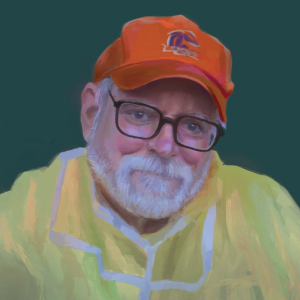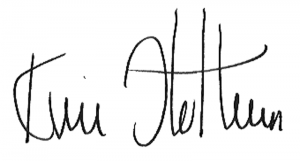Selling Honey. Land Use. Local.
By: Kim Flottum
I have several interests in life that aren’t directly involved with bees, beekeeping and beekeepers, but most of them have a tie somewhere that you could point to and say, sure, that affects what you do every day with bees. And you’d be mostly right.
Jess, my daughter, would be one of those things. Twenty some years ago she moved to Oregon because she loved the forests and water falls and weather. She banged around for a while but eventually married a local and settled in. Hiking and exploring and nature in general became a way of life, and working a variety of jobs was what made that possible. One job was in a small town grocery store, interestingly. Since I grew up in that environment we had something in common to talk about when we visited or phoned because hiking and water falls aren’t part of my life at all. She knew some local beekeepers, and because of the magazine and me, knew enough to talk to them intelligently, which made that part of her life interesting too, though she didn’t have bees or hang out much with those folks.
Oregon kind of fell apart for her last year, and moving to Medina seemed like a good choice so she showed up in June last summer with her cat and dog and stuff. Not long after arriving Kath and I were headed out to the beeyard one day and Jess asked if she could come along. Well, sure I said, a bit surprised because I don’t think she’d ever worked bees, but why not. So we got her suited up (though not quite perfectly because the bees found an opening in the veil zipper, and her fuzzy socks that I hadn’t checked), and out we went. The veil and ankle thing took some of the shine off that day, but with essentially no experience, she did just fine and seemed to enjoy the time with the bees and just being outside. Though not happy about being stung she wasn’t put off and we did this several times last Summer when time permitted. So now she enjoys the bees, and beekeeping and just being outside, which was her life in Oregon. Of course good protective gear helps a lot. So now sometimes we have help, and she has another outside adventure to chase, and something that wasn’t a bee part of my life is now a bee part of my life. And that’s a good thing.
•
Another tie to bees that I don’t get to do enough is to enjoy honey tasting adventures. The book that Marina and I did a bit ago, The Honey Connoisseur, is all about honey plants and how to taste the very different honeys those plants make. From that beginning Marina developed The American Honey Tasting Society. Much like wine tasting, there are specialized classes and techniques and even equipment to use for this. She took tasting a lot further than the book though, and, like those professional wine tasters, called sommeliers, has attended several very specialized classes in Italy specifically aimed at learning the sensory experiences, and the aroma and flavor experiences needed to be a Honey Taster. These classes she took are taught at the Italian National Beekeeping Institute in Bologna. So now she teaches people this art and science, and every year hosts classes you can attend to learn this skill yourself. Chefs, food professionals, brewers, mead makers and beekeepers are standing in line to take these classes in order to make educated selections of the best varietal honey for specific recipes and cheese, beer and mead pairings. For reasons only the honey bee gods are aware of, her classes have always been scheduled at the same time I’m in another state doing something else, so I haven’t been able to attend one yet. This past Summer she had short introduction classes at the EAS conference and we did a FaceBook live event at one of them that you can see on Bee Culture’s FaceBook page. Over 2,000 folks have tuned in so far. They initially scheduled just one class, but demand was so great they had to do several to accommodate all that wanted to participate. This is not a fad, but a growing body of dedicated people who want to learn this fine art.
And she did it again. She’s having two courses this Spring, a two hour class in March and a two-day event in April and I can’t make either one. But if you’re interested, check out the American Honey Tasting Society web page at www.americanhoneytastingsociety.com for more info and registration. I can’t be there, but you can, and there’s only so many seats at the table.
•
Two other things in my world that I find fascinating are anything about water (simply, there isn’t enough of it and how we use what we have), and land use. There isn’t enough of that either, and there’s getting less every day. The USDA does a pretty good job of keeping track of how much land is used, and what it is used for. Over the years they’ve changed some of the definitions of land use, so it’s kind of hard to track some uses over time, but it’s pretty good.
They just came out with updated information on land use and it’s sorted by states, regions and the total of all land in the US. They have specific use categories assigned to urban, crop land, non-crop land, forests, pastures, and others. I’ve always found the urban use data the most interesting because it shows how much land we cover with asphalt. John Miller once said the last crop was always concrete and he was right. Here’s some of the data.
They started keeping this information at the end of the Second World War, 1945. What I like to look at is essentially growth of urban areas over time. Let’s see . . .
Over all, urban land use in the US, between 1945 and 2012 increased 78%. It went from 15,012,000 acres to 69,441,000 acres. You can see below those regions that grew faster, about the same, and slower than over all growth in the country.
- The Northeast – +70%. ME, NH, VT, MA, RI, CT, NY, NJ, PA, DE, MD, Dist. Of Co;
- Lake States – +68%. MI, WI, MN
- The Corn Belt – +71%. OH, IN, IL, IA, MS
- Northern Plains – 66%. ND, SD, NE, KS
- Appalachian – +86%. VA, WV, NC, KY, TN
- Southeast – +89%. SC, GA, FL, AL
- Delta States – +76%. MS, AR, LA
- Southern Plains – +86%. OK, TX
- Mountain – +87%. MT, ID, WY, CO, NM, AZ, UT, NV
- Pacific – +98%. WA, OR, CA
So I knew you’d ask, the population in 1945 was 139.9 million people, and in 2012 it was 314 million people, only a 54% increase. We have more people now than then, but each of us is taking up a lot more room. Move over.
•
Did you look at the Honey Report page this month? It tells not only honey and honey bee product prices across all regions, but it looks at where they sell them. There’s an old saying about being in the beekeeping business, and that’s to stay ahead of the game, you have to get everything but the buzz out of your bees. Every beekeeper, or nearly every beekeeper has honey to sell. Often, too, beeswax, but the most oft asked question is – where do I sell this stuff?
A honey for sale sign in the front yard is a starter. More serious? Get a sign a mile, a half mile and 50 yards down the road in both directions, and have an easy place to pull over. And those signs have to be big enough to read at 65 mph. If you live in the country that is. That’s tough to do if you live in town. But nearly 90% or our reporters are selling on average 30% of their honey from home (actually half of these folks sell 40% or more of their crop this way, and 10% sell all of it this way). Either as a pay as you go stand in the driveway, or inside the front porch, or just on a table out front. It works. And it works because everybody who stops and buys knows the person selling the honey is the beekeeper that made that honey. It’s local, don’t you know. And local honey is almost as good a medicine as Manuka honey, don’t you know.
It’s the same at work. Nearly 50% of our reporters sell honey at work, or at least to people they work with. And almost as popular is selling honey to local Mom and Pop grocery stores. Local is the name of the game today, and has been for some time. But with foreign honey, and all the bad press foreign honey is getting, so much of the game anymore, local is what people want. LOCAL. You can have a label made that says local. I know, my name and address are already on the label, somewhere. But a top label that screams LOCAL works better. A hang tag that says not only local, but what kind is better.
Farm markets, too, sell a lot of honey for not quite as many beekeepers. Farm markets are local. That’s LOCAL again. Farm markets, for the most part, only sell stuff that vendors make. The season long markets are less fussy because it’s tough to get local tomatoes in Ohio in December, unless they come from a green house, or aquaponics operation, and we happen to have both here in Medina, so, yes, those tomatoes actually are local. And they are better than the Florida tomatoes in the grocery store. Much better. LOCAL. Use it. It works.
•
Catalogs. Have you looked at all the catalogs this year. They continue to get better, on average anyway, every year. I listen to small operations complain about the cost of catalog production. The layout and design, printing, mailing. It is expensive. We know because we do something similar every month with this magazine and every three months with BEEKeeping. Layout and design, printing and postage. We don’t mail as many as some bee supply companies do in a single mailing, but over the course of year I’ll be we mail many, many more. One thing I tell these folks about catalogs is to consider them an employee. They go to work every day for you, they don’t complain, they don’t call in sick, they don’t need health insurance, and they don’t goof off. And you don’t have to feed them, clothe them or babysit them. They just do what they are supposed to do, all year long. I have a stack of them at home I keep close all year long. I don’t buy anything from a bee supply catalog, but I use them for reference when I’m doing something like this. They come in handy, and if you don’t use them for that you should. How do I do this? What size do I need? Where can I get one? It’s all there, in that catalog. I have to tell you though, Amazon is all those things but one – Amazon has never answered a question I had about honey bee biology. Not once.
•
It’s March, finally. That woodchuck in PA was right about more winter. It’s been, well, less friendly than the past few years this year. I’ll be glad when I can get the smoker going again. I’m cold.









